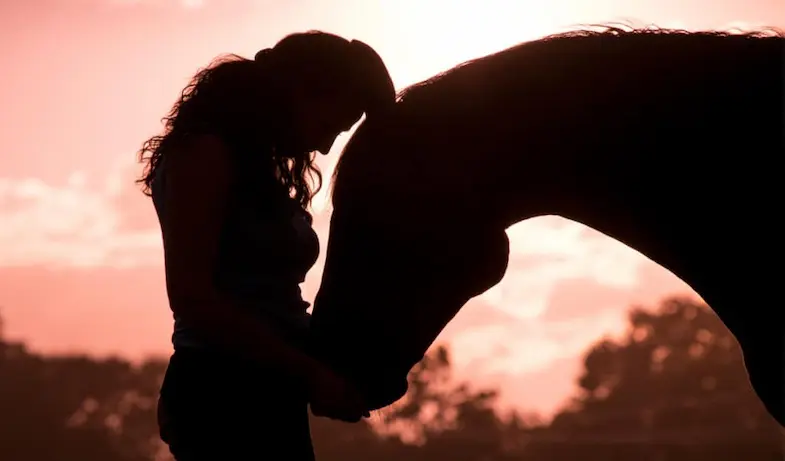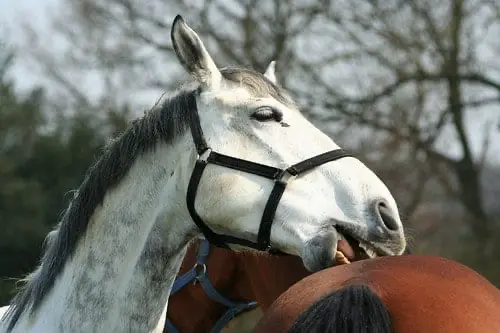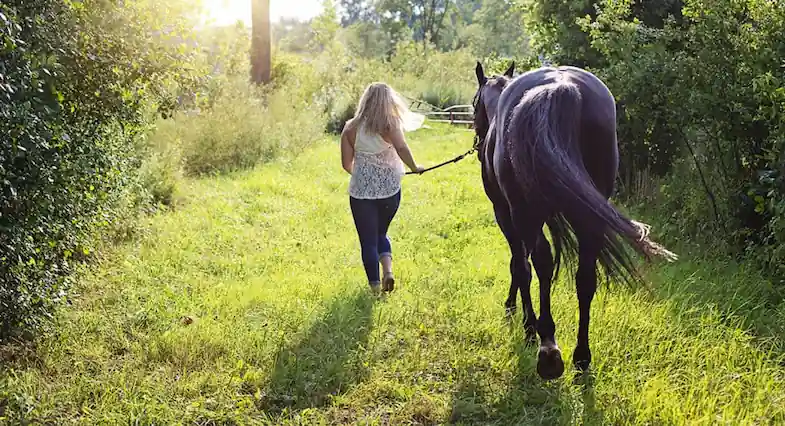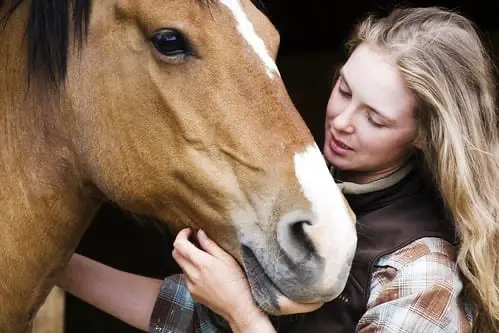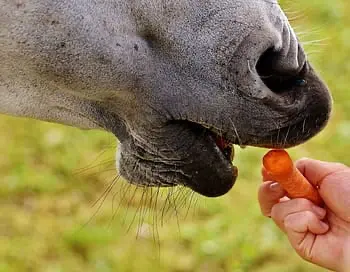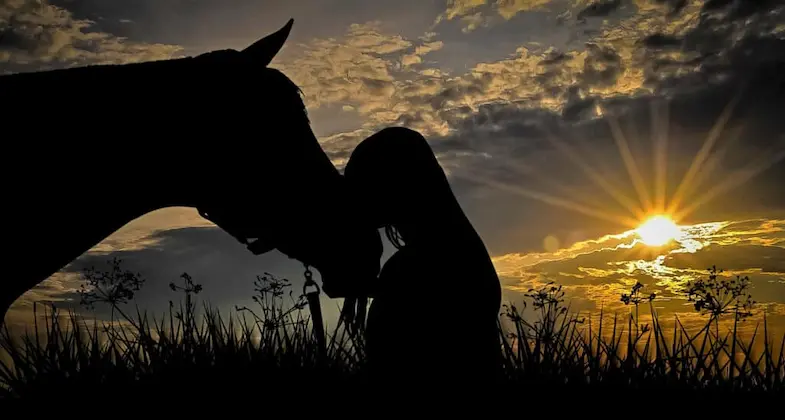Many horse owners will tell you about the wonderful bond they have with their horse and how they both ‘just understand each other’ but if you’re a new owner or haven’t yet bonded with your horse for whatever reason don’t worry, here are some really simple tips that are guaranteed to help the two of you bond. If, however, you already have a good bond with your horse there’s no reason why you can’t increase and improve that bond.
How long does it take to bond with a horse?
How long is a piece of string? Okay so that’s not an answer I know but I’m afraid the real answer is pretty much the same in that there is no one answer. Every horse is different, as is every person, but the amount of time and effort you put in will also make a difference. If your horse is nervous it’ll take longer than it would for a relaxed horse. Likewise, if you’re only able to spare time at the weekend it’ll take you longer than if you are able to invest time every day.
I’ve had horses that I’ve been able to develop a bond with within only a few months but at the other end of the scale, I’ve also had horses that have taken almost two years. It’ll take as long as it takes so don’t put pressure on yourself (or your horse) by expecting the bond to develop quickly.
The more time you spend with your horse the more advantageous it is for your relationship because you’ll be able to understand each other better.
Techniques for bonding with your horse
Bonding with your horse should be a fun experience for both of you and something that you can do together. You don’t need to follow everything below but can just pick the things you think your horse would enjoy the most or that you’d like to do.
The most important thing is to have fun and don’t expect results too quickly.
1) Mutually groom your horse
If you’ve ever watched a herd of horses interact with each other you’ll see how they’re always grooming each other, known as allogrooming, this is a form of social grooming that not only helps horses to keep clean but, more importantly, acts as a way of bonding and reaffirming that bond.
Some horses like to be gently groomed while others prefer a firmer scratch, pay attention to how your horse grooms other horses as well as how they groom him, you can then ‘groom’ your horse in the same way. If you see your horse using his teeth to groom other horses (and vice versa) don’t worry you don’t have to go that far, although you can fool your horse into thinking you are doing that. Just cut a quarter out of an old tennis ball and then cup it in your hand and gently squeeze as you move your way along your horse’s withers – to him, it’ll feel like you’re nipping him which he’ll appreciate.
Once you’ve found your horse’s sweet spot he’ll be eternally grateful which will increase the bond you two have, in the future he’ll be more likely to come to you for you to do it again. Scratching that sweet spot can be very rewarding for your horse, so much so you can use that instead of treats when training him if you’d prefer.
Some horses like to reciprocate by grooming you back, this can be great if your horse is gentle but if he’s not place a quilted blanket over a rail and encourage him to groom that instead.
2) Positive reinforcement
The idea of positive reinforcement isn’t a new concept but the use of it as a bonding technique is relatively new. It works by rewarding your horse for doing the right thing rather than telling him off for doing something wrong, but it’s effective when building a bond because you’re allowing the horse to make his own decisions and mistakes and to learn from them. Your horse will know very quickly, not only when he’s done something good, but exactly what it is that he’s done which will make him feel happy. He’ll associate this positive state of mind with you which is what will increase your bond.
Mares often use a similar method to this when they’re trying to teach their foals something. The mare will gently nudge the foal to get them to move, this pressure will feel uncomfortable and the foal will therefore move, only to be rewarded by a warm drink of milk or a tender nuzzle from his mother.
There are a number of different ways to positively reinforce your horse’s actions but when it comes to bonding clicker training is by far the most effective because unlike a pressure halter (which applies pressure when your horse pulls away from you but releases it when he comes towards you) there’s no negative action for the horse at all. At the same time as you use the clicker, you should also reward your horse (either by grooming his sweet spot (as mentioned above) or with a treat), this will reinforce his actions or behavior but will also make him happy. You can the clicker method whenever you want, whether you’re training your horse, playing with him, or just out for a leisurely ride.
As an added bonus, when you use the clicker method to train your horse he’ll learn far quicker because you’re not constantly telling him what he’s doing wrong, this will obviously make your horse happier and a happy horse (or happy person for that matter) will always be a faster learner.
3) Spend quality time with your horse
It might sound silly to say about spending quality time with your horse because we all like to think that we are but be honest when was the last time you spent time just with your horse and not riding, mucking out, or doing general stable chores? Sadly we don’t spend as much time with just our horses as we think we do (and would like to), but spending time with you can help both of you more than you realize.
We’re living busier lives these days but taking just a little time out and spending it with your horse gives you both a chance to relax but because you’re sharing the experience together it’ll help to develop and improve your bond. You don’t have to do anything special the most important thing is being with your horse, but if you’re not sure what to do then some of these may help:
- Enjoy a picnic while your horse is grazing – You can either take a picnic for yourself and sit near your horse while he’s grazing or take a picnic for the two of you and share it together.
- Relax in your horse’s stall – This is especially good during the winter when it’s cold outside but can be just as much fun during the summer too. Simply take your favorite book with you can sit in your horse’s stall and read, you might need to sit near the door though so you have enough light.
- Talking to your horse – I know this might sound like a silly thing to suggest because we talk to our horses all of the time, but in reality, we spend far more time talking ‘at’ them rather than to them, we’re often asking them to do things (or stop doing things). You might feel silly at first but your horse will respond to the calming tone of your voice, if you’re not sure what to talk about tell him about your day, or any plans you have for the evening. It doesn’t really matter what you say it’s simply the act of talking to him.
Horses enjoy spending time relaxing with each other, it helps to reduce their stress levels but also makes them feel safer and more connected to each other. Doing this with your horse will, in time, mean that he feels the same about relaxing with you.
4) Take your horse for a walk
We don’t often think about taking our horses for a walk in-hand but it can be very therapeutic for you both and will also help to establish good manners, respect and increase your bond. Also, if your horse comes across something that spooks him you can help him to overcome his fear which will build on the trust he has in you, and therefore increase the bond as well.
It doesn’t really matter where you and your horse go, it can be to a field you don’t often go to or somewhere else away from the yard, what’s really important is that its just the too of you and that you both relax and enjoy each other’s company and that you allow your horse to stop and graze when he wants too. The reason this is so good for bonding is that by spending the time together and allowing your horse to freely explore his curiosities you’re actually enhancing the friendship you have.
If you do come across something that your horse is scared of don’t walk him away from it, instead, if you can, pick the object up and allow your horse to see and assess it for himself, making sure you’re talking to him and reassuring him all of the time. When the initial fright has worn off and your horse has realized that it’s not going to eat either of you he’ll start to become curious and want to explore it, again reward him as he does this and continue talking to him to reassure him. Once your horse has decided that the object is okay and has satisfied his curiosity you can put it back where you found it.
5) Why not try horse agility
At first, you might not think that horse agility will help the two of you build a bond (or improve the bond you already have) but it’ll give you the chance to develop your relationship, work through problems, and overcome fears. The idea behind horse agility is pretty much the same as it is with dog agility and that is to build trust and understanding between dog (or horse in our case) and owner, something that’s always done in a fun and enjoyable way for both parties.
Horse agility builds trust because, after a little bit of training, the horse does the course without a lead rope and by following your verbal commands. Building an agility (or obstacle) course is inexpensive and can be done with pool noodles, trotting poles, and other objects you find around the yard, and you can either design your own course or download one from the Horse Agility Club’s website.
If you both really enjoy horse agility then why not consider entering one of the Horse Agility Club’s official online competitions? All you need to do is record your horse and then upload it to their website, you never know you might even win!
6) Groundwork exercises
Every horse owner will tell you the benefits of groundwork (and how it can help with all sorts of things such as bonding, suppleness and even your horse’s confidence) but at the same time, most of us are guilting of not doing it with our horses as often as we should.
Groundwork can help to build a bond because it will help your horse to respect you and your personal space as well as look to you as a leader which will help to increase the trust he has in you and therefore increase the bond.
When doing anything new with your horse, especially when it’s any form of training (which is effectively what groundwork is), it’s always better to start with the basics rather than dive in at the deep end and expect your horse to go with the flow. Start with something as simple as getting your horse to stand still, this might seem pointless but it’s a good place to start from because it’ll teach your horse to respect you. Once you’ve both mastered that why not move onto something more challenging such as training your horse to lead properly.
Getting your horse to stand still doesn’t mean you stand right by his side and hold the lead rope so that he can’t move, the idea is that you teach your horse to stand still on his own. Instead, stand facing each other but with the full length of the lead rope between you. If your horse starts to move give the lead rope a little shake, just enough to signal to your horse to back up. It might take a while for your horse to understand that you want him to stand still but once he does, start to increase the time he stands for then ask him to take a couple of steps forward before asking him to stop again.
When you’re teaching your horse to lead properly the goal is to have him walk with you, staying by your side but without pulling on the lead rope at all, when you stop your horse should also stop. This will teach him to respect your personal space but also to follow your lead.
7) Be relaxed around your horse
Horses are very sensitive creatures that use each other’s emotions as a way of gauging if they’re safe or if there’s any danger around and while you might not realize it they also feed off of your emotions too. If your horse always feels anxious around you he’ll start to think about taking refuge when he sees you, on the other hand, though if he feels relaxed around you he’ll trust you and look to you for reassurance when he’s stressed about something.
Knowing you should be calm and relaxed is one thing but as we all know it can be difficult to always be like this (especially if your horse is testing your patience) but it can really help your relationship, after all, if you’re always making your horse feel nervous and on edge, he won’t want to be around you as much. This is why it’s good to get into the habit of taking a few minutes for yourself before you see your horse, use this time to take a few deep breaths – if you have a smartphone or watch with a breathing or mindful app on it you can use that to help.
As an added bonus horses are drawn to relaxed, peaceful people but having a calm mindset also allows for better communication, which in turn means your horse will be happier and more relaxed himself and therefore respond more positively to training.
8) Be consistent and assertive
Within the herd environment horses have a well-defined hierarchy, with every horse knowing exactly where they are within that pecking order, the alpha horse (or herd leader) is at the top of this and they’re the ones who make the rules and protect the other horses. While this might not seem relevant at first if you can take that role yourself your horse will trust and respect you and look to you to make everything okay for him.
Horses are intelligent animals and won’t just accept you as the alpha, they’ll try and test your authority. It might seem like they’re questioning you, being disobedient, or just completely ignoring you but this isn’t the case, what they’re actually doing is testing your position in the pecking order. This is why you need to be consistent and assertive with your horse, don’t let him get away with doing something half-heartedly or not don’t it properly. It can be difficult at first because it can feel as if you’re being harsh but in the long run, it’ll help your relationship and make your horse respect you even more.
9) Give your horse some treats
We’ve all heard that the way to a man’s heart is through his stomach but whoever said that clearly meant to say the way to a horse’s instead of men’s! We all know how much horses like their food but did you know that you can use it as a way of bonding with your horse.
You can use treats to reward good behavior as well as to train your horse but did you know that when a horse eats endorphins (the brain’s feel-good hormone) are released, making your horse feel happy, relaxed, and generally chilled out.
I know we all have our own opinions of feeding treats but this article suggests some ways to do it without teaching your horse bad habits, if you feel happier giving your horse homemade treats them this article will give you a few healthy treats you can make yourself.
10) Give your horse a massage
You don’t have to train to become a fully qualified equine physiotherapist but learning the basics of equine massage can help you to bond with your horse because he’ll associate you with being relaxed and happy. If you’re worried about not doing it properly or hurting your horse why not use an equine massage pad instead. They can be a little bit pricey but are very effective at massaging your horse properly and in the right places. They can range greatly in price but the cheapest I’ve found is the Equilibrium Massage Therapy Mitt while the Equilibrium Massage Therapy Pad is their ‘top of the range’ product – both of which are available on Amazon.
As an added bonus your horse will perform better too because he’ll be more supple and his muscles will be looser and more flexible.
How can you tell if your horse has bonded with you?
It sounds silly to say but you’ll know when your horse has bonded with you, while they can’t tell you how they feel they certainly can show you which is why it’ll be obvious when the two of you have bonded. He’ll leave his friends (and more importantly his food) to come and see you, he’ll be relaxed around you and will follow your lead.
For more ways horses show affection check out this article or if you’re interested in understanding your horse’s body language read this article.
Further reading
- Loading a difficult horse
- How to calm an anxious horse
- Groom your horse like a pro
- Improve your horse’s confidence
- Caring for an older horse
- Preventing loneliness in horses
- How much space do horses need?
- What your horse’s teeth tell you
- Can horses swim?
- First time owner’s checklist
I hope you found this article helpful. If you did I’d be grateful if you could share it please as it would really help me.
Recommended products
Over the years I have tried hundreds of different horsey products, from various blankets and halters to different treats. Some I’ve loved, others I’ve hated but I thought I’d share with you my top all-time favorite products, the ones I never leave the yard without. I’ve included links to the products (which are in no particular order) that I really think are great.
- Horse Knots by Reference Ready – If you’re like me and enjoy pocket reference guides then you’ll love this knot tying guide. These handy cards can easily fit in your pocket or attach to the saddle for quick reference. They’re waterproof, durable and are color coded to make them easy to follow.
- Mane ’n Tail Detangler – Even if you never show your horse you’ll need to detangle his tail from time to time (and possibly his mane too) which is always a challenging chore! I’ve found that if I run a little bit of detangler through my horse’s tails every few days it stops them from getting matted up and makes combing them easy, even if they’re coated in mud. I don’t know if I should admit to this or not but it also works wonders on my hair.
- TAKEKIT Pro clippers – Over the years I’ve tried a lot of different clippers and while some were obviously better than others I found these to be by far the best. They are heavier than a lot of other clippers but for me, that’s a good thing, it makes them feel more sturdy and hardwearing. On top of that they have a range of speeds so are just as good for clipping your horse’s back as they are his face. I also like the fact that they come in a handy carry case but that’s not for everybody. The company that makes them is super good and incredibly helpful too, a real bonus these days. The only thing I wasn’t keen on was the fact that it doesn’t come with any oil, but that’s not a major problem as it’s not difficult to buy lubricant.
- Shire’s ball feeder – There are so many boredom buster toys out there but I like to use these every day, regardless of whether or not my horses are bored. I find that it helps to encourage my horses to problem solve by rewarding them with treats (or pieces of fruit) but it also mimics their natural grazing behavior which helps to keep them calm and de-stressed.
- Horse safe mirror – This is a strange one that many people are surprised about but I like to put horse safe mirrors in the trailers as well as in the quarantine stalls. It helps to prevent the feeling of isolation by giving the impression of other horses being around. Being herd animals horses can get extremely stressed when they feel that they’re on their own but with these stick-on mirrors, they believe that at least one other horse is with them.
- Rectal thermometer – I know this isn’t glamourous at all but it’s vital for your horse’s well-being to be able to check their temperature and a rectal thermometer is the easiest way of doing this which is why I’ve added it to the list.
Shopping lists
I’ve also put together a few shopping lists of essential items that I’ve found helpful over the years. I’ve broken the lists down into different categories rather than put everything in one massive list 😉

